
Honey is a sweet, viscous food substance made by honey bees and some other bees. Bees produce honey from the sugary secretions of plants or from secretions of other insects, by regurgitation, enzymatic activity, and water evaporation. Honey bees store honey in wax structures called honeycombs, whereas stingless bees store honey in pots made of wax and resin. The variety of honey produced by honey bees is the best-known, due to its worldwide commercial production and human consumption. Honey is collected from wild bee colonies, or from hives of domesticated bees, a practice known as beekeeping or apiculture.
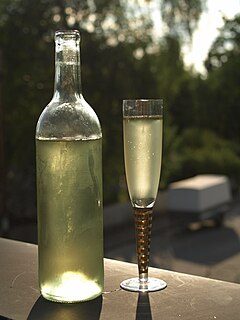
Mead is an alcoholic beverage made by fermenting honey mixed with water, and sometimes with added ingredients such as fruits, spices, grains, or hops. The alcoholic content ranges from about 3.5% ABV to more than 18%. The defining characteristic of mead is that the majority of the beverage's fermentable sugar is derived from honey. It may be still, carbonated, or naturally sparkling; dry, semi-sweet, or sweet.

Kissel or kisel is a viscous fruit dish, popular as a dessert and as a drink in Northern, Central and Eastern Europe. It consists of the sweetened juice of berries, like mors, but it is thickened with cornstarch, potato starch or arrowroot; sometimes red wine or fresh or dried fruits are added. It is similar to the Danish rødgrød and German Rote Grütze. Swedish blåbärssoppa is a similarly prepared bilberry dessert.
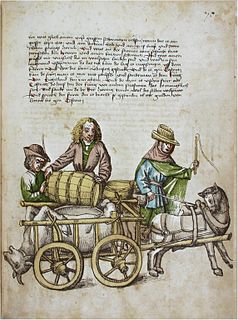
Lithuanian cuisine features products suited to the cool and moist northern climate of Lithuania: barley, potatoes, rye, beets, greens, berries, and mushrooms are locally grown, and dairy products are one of its specialties. Various ways of pickling were used to preserve food for winter. Soups are extremely popular, and are widely regarded as the key to good health. Since it shares its climate and agricultural practices with Northern Europe, Lithuanian cuisine has much in common with its Baltic neighbors and, in general, northern countries. Longlasting agricultural and foraging traditions along with a variety of influences during the country's history formed Lithuanian cuisine.
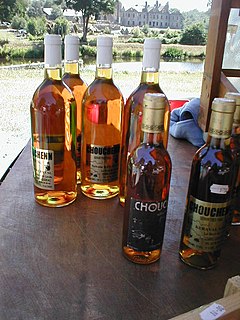
Chouchen is an alcoholic beverage native to Brittany. A form of mead, it is made from the fermentation of honey in water. Chouchen normally contains 14% alcohol by volume. Traditionally, buckwheat honey is used, and this imparts chouchen's strong colour and pronounced flavour.
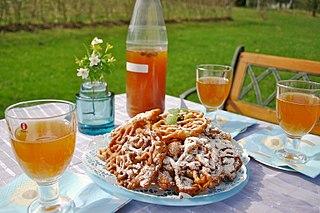
Sima is a Finnish fermented low level alcoholic drink and soft drink. It is traditionally a form of mead, an alcoholic beverage produced by fermenting a solution of honey and water, although nowadays the honey is usually replaced with different kinds of sugar, mostly syrup, which makes it a sugar wine. The drink also has a very low alcohol content due to limited fermentation. Sima is therefore a sweet sparkling beverage that is mainly seasonal and connected with the Finnish Vappu festival. It is usually spiced by adding both the flesh and rind of a lemon.

Tej is a honey wine, like mead, that is brewed and consumed in Ethiopia and Eritrea. It has an alcohol content generally ranging from 7 to 11%. It is often home processed and consists of three main ingredients; honey, water and a medicinal shrub called Rhamnus prinoides [gesho]. Tej is also available commercially to buy in many different types. It is generally consumed during social events such as festivals or weddings, and religious events like Ethiopian New Year [Enkutatash]. Consequently, Tej forms an important part of Ethiopian society and culture and is considered the national drink of Ethiopia.

Belarusian cuisine shares many similarities with cuisines of other Eastern, Central and Northeastern European countries, based predominantly on meat and various vegetables typical for the region.
Lindisfarne Mead is a mead from Northumberland in North East England. It is manufactured in St Aidan's Winery on Holy Island. The mead is unusual in that it blends honey, the traditional main ingredient of mead, with grapes.

Stakliškės is a village in Lithuania, located east of Prienai, in Prienai district of Kaunas County on the Prienai-Trakai road. Stakliškės is a center of Stakliškės elderate. The famous type of Lithuanian mead, an alcoholic beverage distilled from grain, honey and water is produced in Stakliškės. According to the 2011 census, the village had 747 residents.

Kūčiukai also called Christmas cakes - is a traditional Lithuanian dish served on Kūčios, the traditional Christmas Eve dinner in Lithuania. They are small, slightly sweet pastries made from leavened dough and poppy seeds. There are variations in sweetness, it is usually eaten dry but can be served soaked in poppy milk or with cranberry kissel. Initially they were made as small loaves of bread served for the spirits - vėlės.
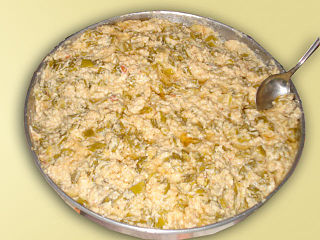
Borani is a salad dish from Iranian cuisine. It is also found in Turkish cuisine where it is associated with certain provinces like Isparta, Urfa and Van. Some versions are made with spinach and yogurt, while the Ancient Persian borani was made with eggplant, and a regional version from Urfa is made with lamb and vegetarian meatballs. Borani is also popular in the Caucasus and Afghanistan.

Sai krok Isan is a fermented sausage originating in the northeastern provinces of Thailand. It is made with pork and rice, and typically eaten as a snack served with bird's eye chilis, raw cabbage, and sliced ginger.
Mırra is a traditional type of bitter coffee prepared in the Hatay, Adana, Urfa and Mardin provinces of Turkey, as well as in some Arab countries like Lebanon and Syria, which is also sometimes correctly referred to as Arabic coffee because the name is derived from Arabic; mur meaning bitter. Since it is very bitter and dark, it is served in tiny cups without handles similar in size to Italian espresso cups. The coffee beans for Mırra are common coffea arabica coffee beans that are roasted twice to increase the bitter taste. They are ground so that they are still grainy, unlike Turkish coffee, which is more like a powder. The coffee is put into a narrow-topped small boiling pot called cezve, and water is added, usually accompanied by some cardamom to give a more aromatic flavour.

Mead is an alcoholic beverage within Polish culinary tradition made by alcoholic fermentation of a mixture of honey and water. It has a characteristic honey aroma and a flavour that may be enriched by the addition of fruit juices, herbs or spices. The colour ranges from golden to dark amber, depending on the type of honey used for production.
Kaysefe is a Turkish dessert made of dried fruits and melted butter. It is a regional specialty of Erzurum. Different fruits may be used including dried apricots or mulberries. First the dried fruit is boiled in water with sugar. Butter is spooned over the boiled fruit and the dessert is garnished with chopped or ground walnuts, pistachios or hazelnuts.
Kabarawan was a traditional pre-colonial Filipino mead-like alcoholic drink. It was made from boiling the ground up aromatic bark of the kabarawan tree until it was reduced to a thick paste. It was then mixed with an equal amount of honey and fermented. It was traditionally consumed from jars with reed or bamboo straws. The wine was mentioned by early Spanish colonists as being made by the Visayan people. However, the tradition has been lost in modern times. Kabarawan tree bark is also used to flavor other types of native wines, like intus and basi, which are both made from sugarcane juice.
Bais is a traditional Filipino mead from the Mandaya and Dibabawon Manobo of northeastern Mindanao. It is made from a mixture of honey and water at varying proportions. It is fermented for at least five days to a month or more.
Daiva Vaitkevičienė-Astramskaitė is Lithuanian folklorist, Senior Researcher, Department of Oral Folklore of the Lithuanian Institute of Literature and Folklore
Byais, is a traditional Filipino wine from the Mansaka people of Davao de Oro. It is made from boiled lengkuas mixed with honey or sugarcane juice which are then fermented in tightly-sealed earthen jars. It has a sharp flavor reminiscent of citrus fruits or pine needles.













